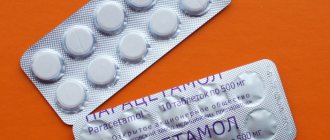Paracetamol
The drug should be taken only in recommended doses!
If you suspect an overdose, even if you feel well, you must stop using the drug and consult a doctor immediately, because There is a risk of delayed serious liver damage and hospitalization may be required.
Symptoms
An overdose of paracetamol may cause liver failure, which may lead to the need for liver transplantation or death.
The clinical picture of acute overdose develops within 24 hours after taking paracetamol. Gastrointestinal disorders appear (nausea, vomiting, loss of appetite, discomfort in the abdominal cavity and (or) abdominal pain), pallor of the skin, sweating.
When simultaneous administration of 7.5 g or more to adults or more than 125 mg/kg to children, cytolysis of hepatocytes occurs with complete and irreversible liver necrosis, the development of liver failure, metabolic acidosis and encephalopathy, which can lead to coma and death.
Ingestion of 5 g or more of paracetamol can lead to liver damage in the presence of risk factors (long-term treatment with carbamazepine, phenobarbital, phenytoin, primidone, rifampicin, St. John's wort or other drugs that are inducers of microsomal liver enzymes; ethanol abuse, glutathione deficiency, digestive disorders , cystic fibrosis, HIV infection, fasting, cachexia).
Clinical symptoms of liver damage (increased activity of microsomal liver enzymes, lactate dehydrogenase, bilirubin concentration and decreased prothrombin levels) appear 24-48 hours after an overdose of the drug and reach a maximum on days 4-6.
The overdose threshold can be reduced in children, in patients suffering from malnutrition, the elderly, patients with liver disease, chronic alcoholism, and in patients taking inducers of microsomal liver enzymes. In such cases, an overdose can be fatal.
In severe cases of overdose, encephalopathy (impaired brain function), cerebral edema, bleeding, hypoglycemia, and even death may develop as a result of liver failure.
It is possible to develop acute renal failure with acute tubular necrosis, the characteristic signs of which are pain in the lumbar region, hematuria, proteinuria (increased protein in the urine), while severe liver damage may be absent.
There have been cases of heart rhythm disturbances and pancreatitis.
Treatment:
Immediate hospitalization. In case of overdose caused by rectal administration of paracetamol, gastric lavage and enterosorbents are ineffective.
The level of paracetamol in the blood plasma should be determined, but not earlier than 4 hours after the overdose (earlier results are not reliable). Laboratory tests of liver microsomal enzyme activity should be performed at the beginning of treatment and then every 24 hours.
The introduction of SH-group donors and precursors of glutathione synthesis - methionine and acetylcysteine - is most effective in the first 8 hours and can be carried out up to 24 hours after taking paracetamol, after which the effectiveness of the antidote drops sharply. If necessary, acetylcysteine is administered intravenously.
In most cases, the activity of microsomal liver enzymes returns to normal within 1-2 weeks.
In very severe cases, a liver transplant may be required. In the absence of vomiting, methionine can be used before the patient is admitted to the hospital. The need for additional therapeutic measures (further administration of methionine, intravenous administration of acetylcysteine) is determined depending on the concentration of paracetamol in the blood, as well as the time elapsed after its administration.
Treatment of patients with severe liver dysfunction 24 hours after taking paracetamol should be carried out in conjunction with specialists from a poison control center or specialized liver disease department.
General information
You may be interested in: The best dermatologist in Moscow: rating and patient reviews
This drug is an analgesic medication that has a weak anti-inflammatory effect. According to the pharmacological classification, Paracetamol belongs to the category of antipyretics. A weak child's body tolerates this drug, especially in the form of suppositories, much easier than most drugs with similar properties. And it has much fewer side effects compared to other modern medications.
The use of this antipyretic drug began more than a hundred years ago, and it is still in demand. It is noteworthy that the use of Paracetamol is acceptable in the treatment of not only children, but also pregnant women.
Reviews
For many decades now, parents have consistently used Paracetamol to lower body temperature in children. Responses to the drug vary slightly, but for the most part they are all positive.
Most parents note the high effectiveness of the product and the speed of its impact. Compared to other forms of medication, suppositories act much faster. In addition, an important advantage of the medicine is its low cost, thanks to which it remains affordable for all families.
As for the disadvantages, some babies experience symptoms of pancreatitis when administering suppositories: abdominal pain, nausea and vomiting. However, all these signs appear extremely rarely and go away quite quickly. Thanks to all these qualities, Paracetamol suppositories are today considered one of the most popular antipyretic drugs used to treat children.
Source
Composition and release form
You may be interested in: City Clinical Hospital 52, Moscow: photo, address, patient reviews, how to get there
All varieties of this medication have one active ingredient - paraacetaminophenol or paracetamol. The concentration of this component in the drug, as a rule, does not exceed 500 mg; for treating children, it is better to use products containing 120-250 mg of the main ingredient. Paracetamol suppositories for children have a truly “pure” composition: in addition to the active substance, only a fat base is present as an auxiliary product, which gives the suppositories a plastic shape.
This partly explains the safety of the drug and the approval of pediatricians for its use in the treatment of infants. By the way, this is an answer to parents who are interested in the question of whether children can take Paracetamol suppositories up to one year. Suppositories are recognized as the safest form of this drug. After all, other types of medicine have a more complex composition; synthetic substances are added to them.
Among other things, the bioavailability of the active substance when using paracetamol-based suppositories for children is significantly higher than in the case of tablets or syrup.
Analogs
According to reviews, in terms of cost, this drug does not need analogues, since its price is already very affordable. In most modern countries of the world, Paracetamol is included in the list of vital medications, so its sale is controlled by the state.
But if the drug is contraindicated or not recommended for any reason, it can be replaced with any other painkiller. To do this, in pharmacies you can find a huge range of medications suitable for each patient.
Today, the number of products containing paracetamol is quite large, so if necessary, replacing the medicine will not be difficult. However, even with structural identity, Paracetamol analogues can differ significantly in the concentration of the active ingredient, additional components and the general way of influencing the child’s body. Typically, doctors mention several analogues:
- “Cefekon D” is the most common drug in pediatrics that has antipyretic properties; the drug is produced in the form of suppositories that can be used to treat infants, the concentration of the active ingredient is 50, 100 and 150 mg per suppository;
- "Viburkol";
- "Perfalgan";
- "Nurofen";
- "Panadol";
- "Genferon";
- "Viferon";
- "Efferalgan."
Contraindications
Of course, as is the case with any other medications, the safety of this drug, especially for a weak child’s body, is very relative. Doctors talk about several restrictions on the use of the drug, in the presence of which you should definitely refuse Paracetamol. So, the contraindications include:
- liver pathologies;
- hematopoietic abnormalities;
- individual hypersensitivity to any ingredient of the product;
- stomach ulcer;
- disorders in the functioning of the kidneys;
- bronchial asthma;
- negative reaction of the body to the effects of non-steroidal anti-inflammatory drugs;
- difficulty with blood clotting;
- diabetes.
According to the instructions, Paracetamol suppositories for children cannot be used if the rectal mucosa is damaged. They are prohibited from being administered if the baby has hypersensitivity to the medicine. In addition, suppositories are not recommended for use as an analgesic and antipyretic for blood diseases and Gilbert's syndrome.
Indications for use
Paracetamol suppositories for children are usually used as an antipyretic, since its effectiveness in relation to inflammatory processes is quite low. In this case, the reasons for the rise in body temperature are completely unimportant. As a rule, the drug is used for respiratory diseases and during infectious epidemics in children's institutions. To a lesser extent, suppositories are suitable for:
- headache;
- neuralgia;
- toothache;
- injuries;
- muscle pain.
According to the instructions for use, Paracetamol suppositories for children are prescribed exclusively to eliminate symptoms and the severity of the clinical picture of the pathology. Although, in general, the medication is very effective for neurogenic, dental, traumatic, burn, headache and even premenstrual pain. The drug is often prescribed for algodismenorrhea, chickenpox, and arthralgia.
At what age can antipyretic suppositories be used? According to the instructions, Paracetamol suppositories for children (250, 120 and 500 mg) can be used from three months.
Peculiarities
The drug is able to penetrate into breast milk, due to which it is transferred to the baby at the time of feeding, but no more than 1% of the dose that the woman took. During gestation, a small amount of the substance is also transferred to the embryo. Doctors also talk about the ability of the sulfates contained in paracetamol to influence the tissue of the liver parenchyma, promoting their necrosis if the patient suffers from a lack of glutathione.


